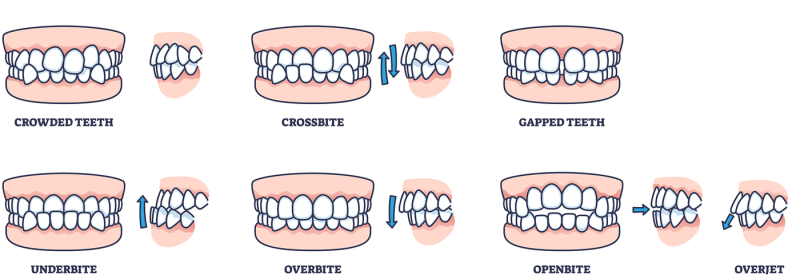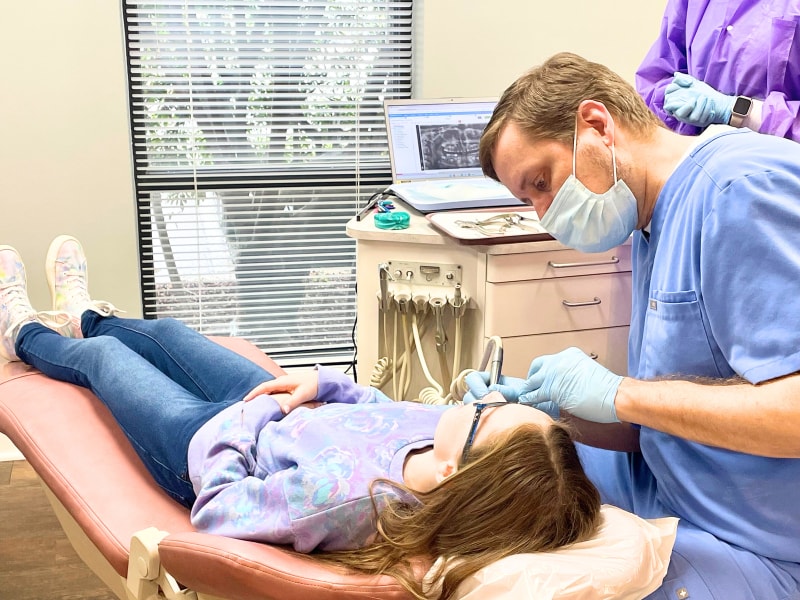Braces 101 - Quick Answers To Your Most-Asked Questions!
July 22, 2025
At McKinney Orthodontics, we believe everyone deserves a confident, healthy smile. If you or your child are considering braces, you're not alone—and you're in good hands! Dr. McKinney and our caring staff have over 23 years of experience in serving our patients of West Alabama and East Mississippi. We would love to help you achieve your BEST smile!
According to the American Association of Orthodontists (AAO) there are over 4 million people in the U.S. with braces at any given time! But before diving in, it’s helpful to understand why braces are important, what the benefits are, and what to expect throughout the journey.

Why get braces? What do they fix?
When you choose McKinney Orthodontics, you’re not just getting braces—you’re getting personalized care. Braces are often used to correct issues such as:
1. Crooked Teeth
Braces align teeth that are rotated, tilted, or out of position.
2. Crowded Teeth
When there isn’t enough room in the mouth, teeth can overlap—braces help space them properly.
3. Gapped Teeth (Spacing Issues)
Braces close extra space between teeth for a more even smile.
4. Overbite
Upper front teeth stick out too far over the lower teeth—braces can bring them back into alignment.
5. Underbite
Lower teeth extend past the upper front teeth—braces can help reposition the jaw and teeth.
6. Crossbite
Some upper teeth sit behind the lower teeth when biting—braces help correct this bite misalignment.
7. Open Bite
When the front teeth don’t touch when the mouth is closed, braces help bring them together.
8. Jaw Misalignment
Braces, sometimes with other appliances, guide the jaw into proper alignment.
9. Speech Issues
By aligning the teeth and jaw, braces can help improve certain speech problems caused by misalignment.
10. Chewing Difficulties
Braces make chewing more efficient and comfortable by correcting bite problems.
What happens if I don't get braces?
Just like your teeth are unique, everyone's teeth move differently as they age. And f course, it’s impossible to see the future, but dental health is fairly predictable:
1. Tooth Decay & Gum Disease
Crowded or crooked teeth are harder to clean properly, increasing the risk of cavities and gum infections.
2. Excessive Tooth Wear
Misaligned teeth can grind against each other, wearing them down unevenly and leading to damage.
3. Jaw Pain & TMJ Disorders
Bite problems can strain the jaw joints and muscles, leading to discomfort, clicking, or even chronic pain (TMJ.)
4. Difficulty Chewing or Speaking
Improper bite alignment can make it hard to chew food effectively or pronounce certain words clearly.
5. Increased Risk of Dental Injuries
Protruding teeth (especially from an overbite) are more vulnerable to chips, cracks, or trauma.
6. Headaches & Neck Pain
Bite and jaw misalignment can lead to muscle tension, causing frequent headaches or neck discomfort.
7. Bone Loss
Severe alignment issues can affect the bone that supports your teeth, potentially leading to bone erosion over time.
8. Bad Breath (Halitosis)
Misaligned teeth can trap food and bacteria, which contributes to persistent bad breath if not cleaned thoroughly.
9. Low Self-Esteem
Many people with noticeable orthodontic issues feel self-conscious about their smile, affecting social and emotional well-being.
10. Complications with Dental Work
Improper alignment can interfere with restorations like crowns, implants, or dentures later in life.

Benefits of Braces — More Than Just a Straight Smile!
Healthier Teeth & Gums
Straight teeth are easier to brush and floss, reducing the risk of cavities and gum disease.
Better Bite Alignment
Corrects overbites, underbites, and other bite issues for proper jaw function.
Improved Chewing
Aligned teeth make it easier to chew, so eating is much more comfortable.
Clearer Speech
Proper tooth and jaw alignment can improve pronunciation and speech patterns.
Less Tooth Wear
Even bite pressure prevents early enamel wear, chipping, or cracking.
Reduced Jaw Pain & Headaches
Proper alignment can relieve strain on the jaw, facial muscles, and TMJ joints.
Lower Risk of Injury
Braces correct protruding teeth that are more prone to being chipped or injured.
Boosted Confidence
A straighter smile often leads to increased self-esteem in social and professional settings.
Easier Future Dental Work
Straight teeth make treatments like fillings, crowns, and implants easier and more effective.
Lifelong Results
With proper care and retainers, the benefits of braces can last a lifetime!

What’s the Best Age to Get Braces?
We treat patients of all ages at McKinney Orthodontics, but here’s a few guidelines for different age groups:
Kids (ages 7–14): The American Association of Orthodontics recommends an initial screening by age 7 because of the unique combination of teeth present at this this age; a child’s 6-year molars are typically visible, along with a few other permanent teeth. After viewing an x-ray of the remaining adult teeth, Dr. McKinney can get a clear picture of their dental future. Early detection can guide jaw growth, make space for adult teeth and avoid complications down the road.
Teens: This is an optimal time for comprehensive orthodontic treatment! Most baby teeth are gone by age 12 and most adult teeth are in around age 13 (with the exception of wisdom teeth). Adolescents are growing rapidly, which allows the jawbone tissue to be softer and more responsive to repositioning.
Adults: It’s never too late - 1 in 3 orthodontic patients are adults! Healthy teeth can be moved at any age, and we have several discreet options like Invisalign or ceramic braces to fit your lifestyle and orthodontic needs.

Steps to Getting Traditional Metal Braces
At McKinney Orthodontics, we make your orthodontic journey as smooth, informative and comfortable as possible.
Free New Patient Consultation - Each patient meets with Dr. McKinney and our new patient coordinators to evaluate your smile, discuss your goals, and review treatment recommendations. This will include estimated timeframes, financing, insurance benefits, and any questions you may have along the way!
Digital X-Rays - We take x-rays, detailed images and/or 3D scans to help us monitor your progress.
Braces Placement - Metal or ceramic brackets are bonded to your teeth and connected with an archwire—this visit takes about 1–2 hours.
Regular Appointments - You'll visit us every 4–8 weeks for adjustments and progress checks.
Braces Removal - Once your teeth are aligned, Dr. McKinney will remove the brackets and polish your teeth.
Retainer Fitting - A custom bonded or removable retainer helps keep your new smile in place long-term.

What Affects How Long You’ll Wear Braces?
The amount of time spent in braces will vary depending on the individual patient. Treatment times can take anywhere between 6 and 30 months, but most standard treatments take around 22 months.
Every smile responds differently to treatment and these timeframes can depend on variables such as:
Age - Younger patients’ teeth and jaws are still developing, which can make treatment faster.
Severity of the Case - More complex issues like severe crowding or bite problems often require longer treatment.
Type of Braces - Traditional metal braces, ceramic braces, and clear aligners each work a bit differently.
Patient Compliance - Wearing rubber bands, keeping appointments, and following care instructions directly impact progress.
Oral Hygiene - Good brushing and flossing help prevent delays caused by cavities or gum issues.
Jaw Growth - Ongoing jaw development, especially in teens, can affect treatment time and outcomes.
Missed Appointments - Skipping checkups or adjustments can slow down your treatment.
Use of Additional Appliances - Expanders, headgear, or elastics may be needed for complex corrections, adding time.
Biological Response - Everyone's teeth move at different rates—some respond to treatment faster than others.
Starting Condition of Teeth - The more misaligned the teeth at the start, the longer it usually takes to straighten them.

What to Know Before You Start
Here are a few helpful things to keep in mind before starting treatment:
Braces take some adjustment – Mild discomfort at first is normal, but your mouth quickly adapts.
Oral hygiene is key – You’ll need to brush and floss carefully around your braces.
Certain foods are off-limits –Avoid sticky, crunchy, or hard foods to prevent damage.
Treatment options – We offer traditional metal braces, clear ceramic braces, and Invisalign® clear aligners. Dr. McKinney will recommend the most effective treatment for your dental needs.
Affordability – McKinney Orthodontics offers in house, interest-free financing with flexible monthly payments. We also accept most insurances and our new patient coordinators will help you maximize your insurance benefits.
Local care – Broken brackets? Quick questions? Our McKinney Ortho team is here to support you every step of the way.
Ready to Transform Your Smile?
At McKinney Orthodontics, we love going on this journey with our patients —from your first consultation to the moment your new smile is revealed. Give us a call today to get started!
📍Locations in Tuscaloosa, Fayette and Winfield, Alabama
📞 Call or text us today to schedule your free consultation!


